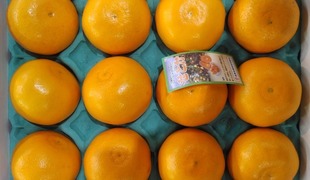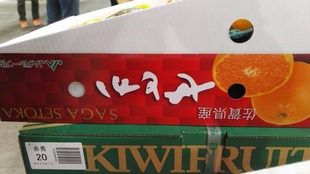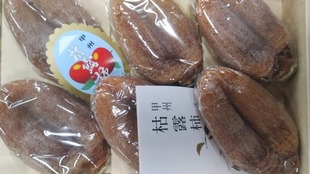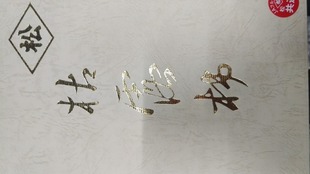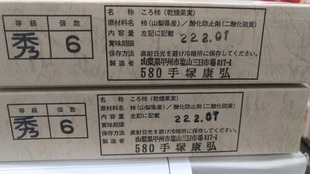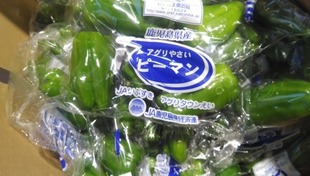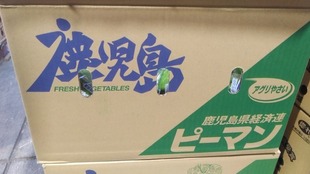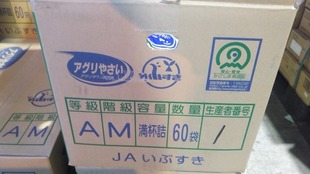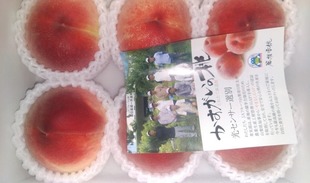【Product name】
Green star cabbage
【Type】
Brassica oleracea var. capitata
【Production area/wholesale area】
Yokosuka City, Kanagawa Prefecture, Hayama Town, Miura District, Zushi City (JA Yokosuka Hayama, Winter and Spring Vegetable Shipping Subcommittee)
【Origin of name】
At the time of 2004, it seems that there was a need to establish a “Green Star(For green (color), [plant] lush, [like a lush plant] youthful, energetic, [fruit] blue, immature, environmental protection [related] ], Environmentally friendly, environmentally conscious, and pollution-free.)” brand, stabilize production, and consider varieties to meet diverse market demands. At the Miura Proving Ground, we are looking for varieties with higher quality and productivity that are as cold-resistant as “Haruharumaru”. “SC9-455” (Sakata) and “T762” (Takii) were found as promising varieties, and it seems that they were testing while changing the sowing time. Cold resistance is in the order of “SC9-455”, “Haruharumaru”, “T762”, and “Kinshun”. “SC9-455” has the advantage that it produces less purple pigment even in the cold, but unlike other varieties, it seems to be a flat head. Therefore, I heard that it was shipped to the market as a test and was evaluated. In addition, it seems that it was found that the harvest within the year is suitable for “T762”.
【Major features】
Soon, in March 2022, the JA will relocate its current head office in Hayashi 3-chome and establish a new “Kurihama branch” in Kurihama, which integrates the four branches of Kurihama, Kita-Kurihama, Uraga, and Sawara. In addition to consolidating management departments such as the finance and mutual aid business and the general affairs department, it seems that they are planning to hold a morning market by local producers using a part of the site. Construction is currently underway as a complex store that promotes locally grown and consumed and plays a role in revitalizing agriculture, and it seems that it will further strengthen management. Nonprofit organization Hayama Town Development Association (Horiuchi, Hayama Town, Miura District, Hayama Town Library 2F) issued a leaflet entitled “Hayama Wildflowers” in early March 2022. It seems that it is characterized by a size that can be seen in each season and can be folded into a pocket. 64 kinds of flowers are recorded on the front and back of A3 size. It seems that each plant name and Japanese name, classification and habitat, as well as characteristics, size, origin of the name, etc. are stored. It seems that each is divided into the seasons that you can actually see. From familiar species such as ferns, camellia japonica, and sarcandra glabra, to the semi-endangered species “Chelonopsis longipes” (a slightly large perennial plant that grows in the slightly moist valleys and watersides of hills and low mountains. The leaves are thin and the flower pattern is clearly longer than the leaf pattern. Also, the leaves are wide and the length of the flower pattern and the leaf pattern is about the same and short. There are also rare species that live in our daily lives, such as). Along with the completion of the leaflet, related exhibitions will be held until March 31 (Thursday) at the gallery of the town development museum. JA Yokosuka Hayama jurisdiction borders Sagami Bay and Tokyo Bay, and there are many lush hills, and it seems that agriculture is nurtured in an environment blessed with nature. The representative of “Yokosuka vegetables”, cabbage and radish from winter to spring is designated as a national production area, and major crops such as pumpkin, watermelon and melon in summer are evaluated by the market as a brand from the Miura Peninsula. It has gained. In addition, fattening of “Hayama beef(In addition to receiving the Minister of Agriculture, Forestry and Fisheries Award for the fifth consecutive year, the finest Japanese Black has been proven with numerous honors. A member of the “Miura Peninsula Dairy Association” selects excellent Japanese beef cow pedigree and raises each one with great care. High quality and stable production So, we systematically selected Tajima breeding bulls, which are said to have the best meat quality. Marbled meat is highly evaluated for its sweetness and deliciousness because it is grown on a unique feed containing cooked grains such as rice and tofu lees. It seems that the melting fat melts just by putting it on the palm of your hand.)”, a brand beef representing Kanagawa prefecture, is also carried out. In 2018, the “25th Ordinary General Assembly” was held on June 25th at Yokosuka Bayside Pocket (Honcho, Yokosuka City). At the table, 23 people, including members who have contributed to the agricultural and cooperative movement, were commended. I heard that six bills were submitted at the general assembly, and all the bills were approved by the majority and passed as originally proposed. “Sukanagosso” will hold an “Anniversary Festival” in June. The event was held for a month, and it seems that it was crowded with many visitors. It seems that each event was a great success, with special product sales by sister JA Aizu Yotsuba “Manma-ja” and all-you-can-eat vegetables. Salad purple, which can be eaten deliciously even with salad, is a public-private joint research with a private seed company by the Kanagawa Prefectural Agricultural Technology Center (200ha, 5,000t of eggplant is cultivated and produced in Kanagawa prefecture, but it is eaten as it is after harvesting. It is expected that the demand will increase at a stretch if new eggplant varieties can be cultivated. Therefore, from 2003, the Agricultural Technology Center will collaborate with Sakata Seed Co., Ltd. to cultivate a combination of excellent traits of parents. It seems that he worked on raising new varieties of juicy eggplants using the one-generation hybrid method. As a result of selection and test cultivation of more than 120 strains, the one-generation hybrid strain that was highly evaluated in the field trial was named “Salad Purple”. An eggplant that can be eaten deliciously with salad, which was developed by filing a variety registration application (application number 21565) on October 10, 2007 and registering on March 19, 2009 (registration number 18153). From 2003, we started to grow new varieties that can be easily cooked like salads, and registered the varieties in March 2009. The shape is a little small drawstring type, but because it is a variety that is mixed with water eggplant, it is juicy enough that the juice drips when you squeeze the fruit, and it seems to be heavy when you pick it up. Compared to general varieties, it has a higher sugar content (salad purple about 3.2%, general varieties about 2.8%), and it seems to have the characteristic that it is hard to discolor even after cutting the fruit. It looks the same as an ordinary eggplant, but the skin and flesh are soft, the inside is white when cut, and the crispy texture like an apple is fun when eaten raw. “サラダ紫” has deep purple leaves and seems to have 4 to 5 more flowers than ordinary eggplants. Not only does the fruit have a characteristic purse-string shape, but it is so juicy that the juice drips when the fruit is squeezed. Therefore, the specific density is as high as 0.9 (about 0.6 for ordinary varieties). In addition, it has a higher sugar content than general varieties and does not easily discolor even after cutting the fruit, so it is a completely new type of eggplant that is very delicious even if you eat it as it is like a salad. (Trial cultivation started in Yokosuka City in 2006, and I hear that it is currently cultivated in various parts of Kanagawa Prefecture. JA Yokosuka Hayama, which has a large shipment volume, started co-sale in 2008, and it seems that 12 producers including direct sales are cultivating at 31.6a in 2013. The cultivation method is the same as for ordinary sardines, and the planting is done during the consecutive holidays in May, and the harvest is done in a size of 120 to 130 g that does not fade, but the harvest starts from the end of June and ships from July to October. It seems to be the peak. In addition to being sold at mass retailers in Kanagawa Prefecture via the market, it is also sold at JA direct sales offices. A soft impression with less lye and sweetness.)In order to raise the name and image of vegetables and fruits produced in Yokosuka City, we can see the logo mark that is used uniformly for PR activities and sales promotion of Yokosuka vegetables. This seems to be a simple and playful design that combines typical vegetables produced in the city with “Sukajan; Japanese souvenir jacket” that can imagine the city of Yokosuka nationwide. Yokosuka vegetables four commitments: Vegetables and fruits from Yokosuka that have been exposed to the sea breeze and the sun, the table is gorgeous with various kinds and colors, and the pride and affection of Yokosuka farmers are put into it. Anyone can easily get it in Yokosuka. There are two types of cabbage from the Miura Peninsula, “early spring cabbage” and spring cabbage. “Early spring” is made from late November to early March, and “spring” is made from early March to early May. It seems. Although it overlaps, the characteristic of “early spring cabbage” is that it is soft and sweet even though it is a midwinter cabbage. Thanks to the warm climate of the Miura Peninsula, it is possible to produce seeds cultivated as spring cabbage in other production areas in winter, soil preparation for farmers using a lot of compost, and selection of varieties by the Agricultural Experiment Station and JA. It can be said that it is the result of efforts. “Spring cabbage” is a cabbage that is suitable for raw food because of its softness and sweetness. JA Yokosuka Hayama’s “Winter / Spring Vegetable Shipping Subcommittee” has installed pheromone traps (pest traps) on almost the entire agricultural land in the jurisdiction to practice environment-friendly agriculture that reduces the frequency of spraying pesticides. It seems that one of the pests of cabbage is the larva of Spodoptera litura (Aomushi). In the past, pesticides were used to kill this larva directly, but the pheromone trap seems to be a completely different idea. Male moths, which are adults of Spodoptera litura, are attracted and caught by the female odor (sex pheromone agent), which seems to reduce the incidence of larvae by reducing the chances of mating and the number of eggs laid. Also, it seems that some farmers mix oolong tea grounds and coffee grounds discarded at beverage factories with compost, and use compost of leftover food made at a nearby training facility. The catchphrase for vegetables made on the Miura Peninsula is “natural taste and healthy vegetables.” I heard that the average temperature of cabbage is 20 ℃, which is a relatively cool climate. It seems that growth will decline even at high temperatures of 30 ° C or higher, but it will not die. On the contrary, it grows even at 5 ° C and seems to overwinter at -15 ° C. It seems that the people concerned think that the fact that they are extremely adaptable to the environment and have strong vitality is one of the reasons why they have acquired the status of important vegetables that are indispensable at present. After spending the cold winter months, the cabbage has a physiological phenomenon of trying to bloom when exposed to the warm spring sunshine. The flower buds in the center of the cabbage grow, and the flowers seem to bloom at the tips of the stems. It is often said that this is a “sprout”, but it seems that farmers dislike this phenomenon because the flower buds grow by breaking the rounded cabbage and the commercial value is lost. Currently, I buy and sow the selected F1 seeds, so it seems that there is no need to bloom and pick seeds. Is the important work of leaving offspring for cabbage disliked by farmers? There are many individualities in this agricultural product family, and in addition to the ordinary cabbage that you see on a daily basis, cauliflower, broccoli, Brussels sprouts, call rabies, and leaf peony Is also a member of the Brassicaceae family, and seems to be even more diverse when it comes to relatives. In addition, the scientific basis for the curling of the leaves of these agricultural products seems to be that research data says that the leaves bend inward because there is a difference in hormone formation between the inside and outside of the leaves due to the influence of light. The identity of the hormone is still opaque and has not been completely elucidated, but it is called auxin(The action of loosening the cell wall is known in many plant species. At the plant level, various physiological activities such as tropism to light and gravity, apical bud dominance, eccentric growth, root induction from callus, fruit fruiting, participatory fruiting, and organ detachment are prominent. It has also been elucidated that plants accumulate in the injured area and differentiate the soft cells around the severed vascular bundle into duct cells. Auxin-like active substances are classified into natural auxins and synthetic auxins according to the presence or absence in plants. Natural auxins include indole-3-acetic acid (IAA) and indole-3-butyric acid (IBA), and synthetic auxins include 2,4-dichlorophenoxyacetic acid (2,4-D) and 1-naphthalene acetate (NPA). It seems. IAA is generally polar auxin transport from shoot apex to root tip, and the fact that this auxin transport is inhibited by auxin polar auxin transport inhibitors has also been elucidated. The genes for transport proteins involved in migration have been cloned, and it seems that transport proteins can be divided into influx carrier protein and efflux carrier protein. Accepted by a nuclear-localized F-box protein called the TIR1 protein. It can be confirmed that the TIR1 receptor promotes proteolysis of the negative regulator Aux / IAA transcription inhibitor in the presence of auxin.)or ethylene; C2H4 ≒ CH2=CH2, and in the experiment, it seems that the amount of ethylene produced is the maximum immediately after the start of heading of cabbage. In other words, it seems that it is the plant hormone ethylene that triggers the rounding of the leaves. Cultivation of cabbage is the second oldest after radish, and it is said to be around 1892. In 1925, it seems that joint shipment of “early cabbage” was carried out in the Takeyama district of Yokosuka city. After that, the planted area gradually increased, but it seems that there were many nostalgic “winter cabbage” and “Kandama; Cold ball cabbage” in terms of varieties. As for the soft cabbage as it is now, a variety called “Kinteki” was cultivated in Miura City in 1966, and this seems to be the first cabbage in early spring. It seems that the cultivar “Kinshun(From Sakata Seed Corporation, it is most suitable for warm regions from the end of the year to early spring, and general regions for the year. Cold resistance is inferior to that of cold ball varieties, but it seems to be slightly stronger than Wase cabbage. The grass shape, balls, and meat quality are very similar to those of the autumn-sown Goku Wase variety. The mesophyll is soft, juicy and sweet, and is popular as an early-maturing cabbage in the market. Since the outer leaves are not too large, it seems to be easy to use for the spring cabbage cropping from April to May. Compared to “Kin type 201”, the grass is slightly larger and the leaves are darker. The ball is one size larger and seems to weigh around 1.5 kg. The tightness is good, but the maturity seems to be a little late. In early spring in warm regions, it seems good to keep in mind the cultivation of healthy seedlings and the timely planting of young seedlings. Planting seems to be done by early October. Since the cold resistance after heading is weak, it seems better to harvest early in the year after heading.)” that is currently being made was introduced in 1977. In 1966, Yokosuka City, along with Miura City, became a designated production area for cabbage based on the Vegetable Production and Shipment Stabilization Law, and more than 50 years have already passed. “Green Star” is the main item of early spring cabbage shipped from the latter half of October to March. While many hard cabbage are shipped in other production areas during the cold season, it seems that they are shipping soft and sweet cabbage by taking advantage of the warm climate of the Miura Peninsula. Spring cabbage is a very soft cabbage that ships from March to May. It’s the perfect variety to eat raw in the early spring when it gets warmer. It has been evaluated as a production area for a long time and is famous as a representative of agricultural products on the Miura Peninsula. The number of varieties called “Haruharumaru”, which is more cold-resistant, is increasing. Sour cabbage suitable for summer sowing in warm regions from January to March from Minamikatae, Jonan Ward, Fukuoka, where the head office of Nippon Agris Co., Ltd. is located. It has excellent low-temperature hypertrophy and cold resistance, and has excellent fieldability because it has a particularly slow fissure. The weight of the sphere is 1.3 to 1.5 kg, and it seems to be a well-matched oblate sphere with a good buttock shape. I heard that the grass is strong, it is resistant to diseases such as Sclerotinia sclerotiorum and Xanthomonas campestris pv. Campestris, and it is easy to cultivate.
【Nutrients/functional ingredients】
Protein: macromolecule; Structural proteins make up the body, and functional proteins are proteins involved in digestion, transportation, and chemical reactions. Digestive enzymes such as pepsin(aspartic endopeptidase)and trypsin(Endopeptidase & Serine Protease), which are cut by digestive enzymes and decomposed into small peptides and amino acids, absorbed and digested finely, are also made from amino acids.
脂質 ; It has important roles such as being used as an energy source, becoming a component of cell membranes, organs, and nerves, and assisting the transport of vitamins. It keeps a person’s body temperature, moisturizes and glitters the skin, helps normal hormones work, and has an active function. Women, in particular, can be detrimental to beauty and health and need some lipids for beautiful skin and hair. However, if the intake is too high, it will be stored as fat.
炭水化物; It is a compound of carbon(Ca)and hydrogen(H), and is divided into sugar, which is taken into the body as food and used as an energy source, and dietary fiber, which cannot be digested by digestive enzymes in the body.
βカロテン: C40H56; Converted to vitamin A in the body as needed. Carotenoids that are abundant in green and yellow vegetables.It is important for maintaining the health of skin and mucous membranes and for photostimulatory response, and promotes cell proliferation.
ビタミンB1: Decarbonization in the ketoglutarate dehydrogenase reaction: Coenzyme; Form of thiamine pyrophosphate.
B2; The form of flavin adenine dinucleotide as a cofactor for the α-ketoglutarate dehydrogenase complex and succinate dehydrogenase.
B6: Pyridoxine(C8H11NO3), Pyridoxal(C8H9NO3), Pyridoxiamine(C8H12N2O2); Coenzyme for protein, lipid and carbohydrate metabolism: It acts as a coenzyme(Pyridoxal phosphate)for metabolism of bioactive amines, which is a neurotransmitter, and as a hormone regulator: Helps keep nerves and skin healthy, fight infections, keep blood sugar levels normal, produce red blood cells, and some enzymes work properly.
ナイアシン: C6H5NO2; The form of nicotinamide adenine dinucleotide as a coenzyme of isocitrate dehydrogenase, α-ketotoglutarate dehydrogenase, malate dehydrogenase.
パントテン酸: C21H36P3N7O16S; Cofactor fused with active carboxylic acid residues such as Acyl coa and succinyl-coa: Coenzyme A(Cysteamine)
ビオチン(5-[(3aS,4S,6aR)-2-oxohexahydro-1H-thieno[3,4-d]imidazol-4-yl]pentanoic acid: C10H16N2O3S):ビタミンH; It is a colorless acicular crystal that is stable to neutral, acidic, alkaline, oxygen, and light, but weak to heat. It is released from proteins in food by biotinidase(dominant gene)secreted by the pancreas. It translocates into the blood and binds to biotinidase, a transport protein synthesized in the liver.
葉酸: ビタミンM(2S)-2-[(4-{[(2-amino-4-hydroxypteridin-6-yl)methyl]amino}phenyl)formamido]pentanedioic acid: C19H19N7O6; Pteridine(C6H4N4)with para-aminobenzoic acid; PABA(C7H7NO2)and another or more glutamic acids. Most exist in the “Polyglutamic acid type” (A combination of multiple glutamic acids). I heard that it is absorbed from the epithelial cells of the small intestine after being converted to the “Monoglutamic acid type” (A form in which one glutamic acid is bound) by digestive enzymes in the digestive tract. It is soluble in acids and alkalis, but hardly soluble in pure water or ethanol, and tends to be insoluble in acetone(C3H6O), diethyl ether((C2H5)2O), chloroform(CHCl3), and benzene(C6H6). In the polyglutamic acid type folate, sugar and protein are released and released in the cooking and processing of foods and in the gastric acid environment.It is decomposed into monoglutamic acid-type folic acid by an enzyme in the small intestinal mucosa and then absorbed into the cells of the small intestine.I heard that it is converted to 5-methyltetrahydrofolic acid by the enzyme(small intestinal epithelial cell). It is transported to the liver via the portal vein, and 50% of the whole body seems to accumulate. It is converted again and transferred to bile, which is reabsorbed from the digestive tract and supplied to tissues for transfer. It is required to return homocysteine, a risk factor for arteriosclerosis, to methionine.etc.
ビタミンC: C6H8O6: Discovered as a Skorbut preventive factor by Royal Navy doctor James Lind in 1753. It removes rust from water-soluble parts of the body, such as blood and the crystalline lens of the eye, and also restores tired vitamin E. It is absorbed mainly from the small intestine as it is without being digested by the stomach. It is then carried in the blood, stored and dispersed throughout the body. It is characterized by its “antioxidant effect”, which inhales, captures a small amount of active oxygen obtained, and detoxifies it. Excessive growth damages DNA or Protein and reduces cell function.
ビタミンE: C29H50O2:(Action of Vitamin E as an Antioxidant The study on the action of vitamin E as an antioxidant has been summarized aiming specifically at discussing the mechanism and rate of radical scavenging, relative activities of α-, β-, γ-, and δ-tocopherol, behavior of vitamin E in the membranes, effect of phytyl side chain, synergistic inhibition of oxidation with vitamin C, interaction with iron, and suppression of oxidative hemolysis of erythrocytes. Department of Reaction Chemistry, Faculty of Engineering, University of Tokyo, Journal of the Vitamin Society of Japan Vitamins 1988)
ビタミンK: 2-メチル-3-(3,7,11,15-テトラメチル‐2‐ヘキサデセニル)-1,4-ナフタレンジオン: C31H46O2; Activates bone osteocalcin(protein)and arterial matrix Gla(γ‐carboxyglutamic acid: C6H9NO6; Produced by carboxylation of some specific glutamates of blood coagulation proteins)protein. Calcium metabolism in the body(Physiological effects through a series of cells that occur throughout the body)Helps regulate, maintain bone and artery health.
ビタミンU: C6H15NO2S+: S-methylmethionine: Effects of Nitrogen Fertilization and Cropping Season on the Vitamin U Concentration in Cabbage, Vitamin U (VU) concentration in cabbages harvested in Hokkaido ranged from 7.0 – 66.2 mg kg −1, and the mean was 28.9 mg kg −1 (1996-1998, n= 92). Among cropping seasons, the mean VU concentration in cabbages was highest in July (40.6 mg kg −1), then declined gradually until October (13.2 mg kg −1). VU concentration in cabbages increased with increases in applied nitrogen (N) fertilizer, or growth in fields with higher N fertility, and in summer cropping rather than autumn cropping. In the case of cabbbage production using organic matter to reduce usage of chemical fertilizer, the VU concentration in cabbage grown with fish meal (fast-N-release) was higher than that growth with rice bran (slow-N-release). These results indicate that changes in VU concentration in cabbages depend on N nutritional condition(Hokkaido Central Agricultural Experiment Station and Hokkaido Ornamental Plant and Vegetable Research Center, Horticultural research (Japan) 2004).
スルフォラファン: C6H11NOS2; Detoxification enzyme inducing activity(Determining the catalytic role of remote substrate binding interactions in ketosteroid isomerase: Enzymes that catalyze the transfer of double bonds in steroidal substrates)
ジアスターゼ: Both β and α act jointly on starch. The β-limit dextrin, which is a product of β-amylase, is also degraded by α-amylase, and the product is again degraded by β-amylase. The ultimate product is mainly maltose, and the others are lower dextrins((C6H10O5)n )such as glucose and maltotriose(C18H32O16).
ブドウ糖: C6H12O6: D-グルコース: Known as a component of cellulose, starch and glycogen. D-glucose(Dextrose, an organic compound.)and pure crystalline monosaccharides produced after the starch is completely hydrolyzed. It is divided into water-containing water containing molecular water of crystallization and anhydrous water containing nothing.
グルコシノレート: Published on 2020.02.13: Carcinogenic preventive ingredient is a sulfur storage substance of cruciferous plants. A research group led by Associate Professor Mrs. Akiko Maruyama of the Graduate School of Agriculture, Kyushu University discovered ß-glucosidase (BGLU) 28 and BGLU30 as enzymes that work to decompose glucosinolates when plants are placed in an environment low in sulfur. Published online in the international academic journal “Plant and Cell Physiology”
インドール-3-カルビノール: C9H9NO
ペクチン: methyl ester: J. Braconnot,1825(Rf): Galacturonic acid:carboxyl group: -C(=O)OH
セルロース:(C6H10O5)n; The main component of plant cell sell stones and plant fibers, and the most abundant carbohydrate on earth.
ヘミセルロース(Amyloid): Discovered by E. Schulze in 1891. The name of the polysaccharide extracted with alkali after extracting Pectin from cell wall carbohydrates. Xyloglucan(Angiospermae): With 1,4-β-D-glucan as the main chain, the α-D-xylose residue binds to the O-6 position of the D-glucose residue of 75%. It is distributed throughout the cell wall including the middle lobe, and I hear that it is hydrogen-bonded to cellulose. Tendency to exist as a storage polysaccharide in seeds.
リグニン: Sphingomonas paucimobilis SYK-6: bacterium: Mineralization; Effective resistance to decay and feeding damage.
葉緑素: クロロフィル(Photosensitizing Decomposition of L-Ascorbic Acid by Chlorophylls and Chlorophyll Derivatives)The effects of chlorophyll a, pheophytin and chlorophyll metal derivatives on the photochemical decomposition of L-ascorbic acid (AAH2) and also the photochemical decomposition of chlorophyll-AAH2 system with co-existence of potassium ferri-cyanide, p-quinone and β-carotene as fluorescence quenching agents was studied. 1. The photochemical decomposition of AAH2 was greatly accelerated by the existence of chlorophyll a and pheophytin, and the photodecomposition rate was also promoted with Cu-chlorophyllin-Na and Fe-chlorophyllin-Na, especially, by the former.Cu-chlorophyllin-Na itself oxidized AAH2. 2. The photodecomposition of chlorophyll-AAH2 system was protected with the co-existence of K3 Fe (CN) 6, p-quinone and β-carotene. However, the effect of p-quinone seems to be accelerated the photodecomposition of chlorophyll-AAH2 system in higher concentration. 3. Chloropyll, and pheophytin have comparatively strong fluorescence intensity, whereas Cu-chlorophyllin-Na and Fe-chlorophyllin-Na have week fluorescence intensity. The mutuality relationship was found between the fluorescence intensity of the reaction system and the photochemical decomposition of AAH2. Hiroshima Univ. Department of Education, Journal of Japanese Society of Nutrition and Food Science 1970)
カリウム: K; Adult: Potassium: It interacts with “sodium”, which is abundant in extracellular fluid.It works to maintain the osmotic pressure of cells and retain water. After ingestion and absorption in the small intestine, it is transported to tissues throughout the body, most of which is excreted by the kidneys. It is maintained by regulation of reabsorption in the kidney, and the k concentration in blood is maintained between 3.6 and 4.8 meq / l. Together with sodium, it maintains cell osmotic pressure.It works to suppress nerve stimulus transmission, functional regulation of heart and muscle, and intracellular enzyme reaction(I have to add proton transfer equilibrium). I heard that about 200g is contained in the body of an adult.
ナトリウム: Na; In the adult body, most of it is contained in extracellular fluid outside the cell. Approximately 50 % as salt (sodium chloride), bicarbonate, phosphate.About 40 % is present in the build and is slightly contained in the intracellular fluid. Functions such as osmotic pressure adjustment: Roles such as maintaining the amount of extracellular fluid. Normally, healthy people do not have a deficiency. It is possible to promote the excretion of sodium by taking vegetables and fruits that are high in potassium together. This is because it has been confirmed that taking too much increases the risk of swelling, thirst, high blood pressure, stomach cancer, and esophageal cancer.
カルシウム: Ca; In the body, the amount in cells and blood is strictly controlled. Tendency to move from bone to blood as needed. About 99% is stored in bone, but also in the blood of cells and muscles. If you don’t get the calcium you need, you risk mobilizing large amounts of calcium in your bones and weakening your bones.To maintain normal blood calcium levels, it is necessary to take at least 1000-1500 mg daily. Parathyroid hormone(PTH)and Thyrocalcitonin(Made by the cells of the thyroid gland, hormones have the function of lowering the calcium concentration in the blood by delaying the breakdown of bones.); It is made up of four parathyroid glands behind the thyroid gland in the neck. As the calcium concentration in In blood rises, the amount of hormones produced by the parathyroid glands tends to decrease. It stimulates bones to release calcium into the blood and reduces the amount of calcium excreted by the kidneys into the urine. Increases calcium absorption by stimulating alimentary canal to increase calcium absorption by promoting the activation of vitamin d in the kidneys.
マグネシウム: Mg;(Vinegar has been known to solubilize insoluble calcium (Ca) and magnesium (Mg) in food, however, the difference in solubilization ability among various kinds of vinegar has not been investigated. In this study, solubilization of Ca and Mg from coral powder and beef bone powder was compared with several kinds of vinegar. Calcium solubilization was observed to be high in grain vinegar, cider vinegar and wine vinegar, and low in rice vinegar and un-polished rice vinegar. On the other hand, magnesium solubilization was high in rice vinegar, wine vinegar and cider vinegar, and low in grain vinegar and un-polished rice vinegar. Calcium solubilization of coral powder was significantly negatively correlated with the pH of vinegar, while Mg solubilization was not. Comparison of solubilization of Ca in un-polished rice vinegar and acetic acid solution suggested that the phosphorus content was also responsible for solubilization in un-polished vinegar. These results suggest that ingredients in vinegar, as well as acidity and pH, affect solubilization of Ca and Mg from food when cooked with vinegar. Characterization of Solubilization of Insoluble Calcium and Magnesium with Various Kinds of Vinegar, Nakano Central Research Institute, Nakano Vinegar Co., Ltd. and Department of Applied Biological Chemistry, Faculty of Agriculture, Tohoku University with Nippon shokuhin kagaku kogaku kaishi = Journal of the Japanese Society for Food Science and Technology 45(11), 655-662, 1998-11-15)
リン: P;(Leakage in urine causes symptoms such as hypoproteinemia, decreased renal function, and hyperphosphatemia.)The amount of phosphorus per 1 g of protein contains about 15 mg, and the intake correlates with the protein intake. The role of combining and strengthening bones and teeth. Higher blood phosphate levels tend to make bones brittle. Calcium tends to combine and become coal in other than bones such as blood vessels and tendons.
鉄: Fe; It is attracting attention as one of the world’s three major deficient micronutrients along with vitamin A and Iodine(I2; In 1811, Discovered by burning seaweed with potassium carbonate, which is the raw material for potassium nitrate by Bernard Courtois(仏).)Non‐heme iron(Fe)(Included in vegetables, eggs and milk.); By taking it with foods rich in high-quality protein and vitamin C, the absorption rate into the body is improved. Fe shortage of women due to blood loss, a big problem for expectant mother and lactating women whose demand increases.Due to the metabolism of the body, about 1 mg of iron(Fe)is lost in adult men and about 0.8 mg in women per day. Ferritin(A globular protein complex consisting of 24 proteins.)has a role of suppressing deficiency and excess, and is also called stored Fe. About 90% of anemia is iron deficiency, which is deficient in fe, one of the important materials of hemoglobin.
亜鉛: Zn; Zinc‐deficiency symptom: A state in which the zinc concentration in the blood is below 80 μg / dL to 130 μg / dL. Dermatitis, stomatitis, alopecia, pressure ulcer due to lack. Loss of appetite, developmental disorders, hypogonadism, susceptibility, dysgeusia, anemia, infertility, etc. Various symptoms occur and tend to improve with zinc supplementation.
銅: Cu ;It has been known for a long time as a trace essential mineral, which is present in the human body at about 80 mg. It binds to proteins and plays a role in catalyzing a wide range of in vivo reactions. Tendency to be mainly present in bone, skeletal muscle and blood. Although it is involved in hematopoietic function as well as Fe, no reports have been heard regarding the adverse effects of chronic overdose, except for some diseases. Monovalent compounds exist as insoluble salts and complex salts. Divalent salts and complex salts are common. It is absorbed from the small and duodenum and transported to the liver through the portal vein. I hear that the lower the intake, the higher the absorption rate, and the higher the intake, the lower the absorption rate. Large amounts of divalent iron and tin ions competitively inhibit the absorption of copper from the gastrointestinal tract. Inborn errors of copper metabolism(Wilson’s disease): Protein binding: Hepatolenticular degeneration. It acts as a Cu enzyme and acts as a catalyst for various reactions such as O2 transport, electron transfer, redox, and O2 addition. Important for Fe metabolism and transport, removal of active oxygen, and metabolism of neurotransmitters. Deficiencies can result from hereditary malabsorption or are acquired, but are not found in the normal life of healthy people. On the other hand, cases of symptoms are given to Babies whose main source of nutrition is low-content milk.Insufficiency may cause anemia, leukopenia, and bone abnormalities that do not respond to Fe administration. In addition, there are decreased immune function, cardiovascular abnormalities, and abnormal cholesterol and glucose metabolism. However, this is less frequent.
マンガン: Mn; Functions as an enzyme activation and a component of metal enzymes. It is a silver-white metal with an atomic number of 25 and an atomic weight of 54.94, and its surface is oxidized in the air. I hear that 12(For a weight of 70 kg)to 20 milligramme is present in the body of an adult. It acts directly with many elements, gradually reacts with water, and is easily dissolved in acids. Absorbed by inhalation, oral or transdermal: Ingested from the diet, it dissolves as divalent by gastric acid and becomes trivalent by the oxidative mechanism of intestinal cells. It is absorbed, transported to the liver through vena portalis, secreted from the bile into the intestinal tract, and mostly excreted as feces. Since absorption competes with Fe, manganese tends to be less likely to be absorbed if the iron content in the diet is high. It is abundant in mitochondria, and is contained in high concentrations in pigmented areas in the body such as the retina, hair, and skin pigmented areas. It suggests specific and non-specific effects on many enzyme activities such as oxidoreductase, hydrolase, dehydrogenase, and transferase. It is also a component of arginine-degrading enzyme, lactate dehydrogenase, and manganese superoxide dismutase (MnSOD). Examples include connective tissue and bone formation, inner ear growth formation, glucose tolerance, fertility, lipid metabolism, growth and involvement in brain function.
クロム: Cr; Usually, it is in the state of trivalent chromium and hexavalent chromium. Although its content in food is extremely low, it is involved in the metabolism and maintenance of sugars, cholesterol, connective tissue and proteins in vivo. It does not rust in the air or water, but what is interesting is that it dissolves in hydrochloric acid and dilute sulfuric acid. It is absorbed mainly in the small intestine, but its intestinal absorption mechanism has not been clarified. The only mineral whose content in the body decreases with age. Complete venous nutrition that does not contain it or high-calorie infusion may cause impaired glucose tolerance. However, there is room for improvement of symptoms by supplementing Cr chloride. Insufficiency may lead to decreased insulin sensitivity, abnormal nitrogen metabolism, weight loss, peripheral neuropathy, stupor, and corneal disorders.
モリブデン: Mo; In the human body, it acts as a component of the molybdenum enzyme that catalyzes the redox reaction. I’ve heard that hypervitaminosis is not a problem because it is relatively less toxic than other heavy metals. It dissolves in hot concentrated sulfur acid, but does not react with H2O, hydrochloric acid(HCl), and dilute sulfuric acid(H2SO4)and does not dissolve. It is abundant in the liver and kidneys in the body and tends to be easily absorbed in the stomach and small intestine. Xanthine oxidase(NAD+-xanthine dehydrogenase), aldehyde oxidase, and sulfite oxidase are known as constituents. Insufficiency often causes tachycardia, hyperventilation, night blindness, etc. due to long-term complete parenteral nutrition. However, I heard that the administration is expected to improve the symptoms. In healthy people, hypervitaminosis is not a problem in a normal diet because it is excreted quickly even if it is ingested excessively. Chronic poisoning can cause gout-like symptoms such as joint pain and hyperuricemia. Acute poisoning can cause gastrointestinal disorders with diarrhea, leading to coma and heart failure. It is abundant in cereals, legumes and nuts.
【効果効能】
風邪予防: Prevention of cold
美肌・美容: skin care beautiful skin
疲労回復: Recovery from fatigue
血液改善: Blood improvement
血行促進: Improve blood circulation
血栓予防: Thromboprophylaxis
止血作用: Hemostatic action
骨粗しょう症: Osteoporosis
抗腫瘍性: Anticancerous
抗酸化作用: Antioxidative effect
胃腸障害: Gastrointestinal injury
胃潰瘍: Gastric ulcer
消化促進: Digestive
視力維持: Maintaining eyesight
糖尿病: Diabetic mellitus
整腸作用: Regulation of the function of intestine
吹き出物抑制: Breakout suppression
発癌抑制: Carcinogenesis suppression

Early spring cabbage “Green Star” is the main item of early spring cabbage shipped from the latter half of October to March. While many hard cabbage are shipped in other production areas during the cold season, we are shipping soft and sweet cabbage by taking advantage of the warm climate of the Miura Peninsula. Spring cabbage is a very soft cabbage that ships from March to May. The best variety to eat raw in the early spring when it gets warm. It has been evaluated as a production area for a long time and is popular as a representative of agricultural products on the Miura Peninsula.
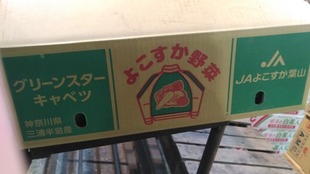
On the Miura Peninsula, many sweet and raw cabbage varieties are produced. Since the leaves are very soft, they are harvested leaving the outer leaves so that they will not be scratched when shipping, and they are carefully wrapped and put in cardboard. By doing this, it seems that the freshness will last longer. The price is a little higher than other production areas, but it is a proof that the quality is evaluated by the market people who are experts in vegetables.
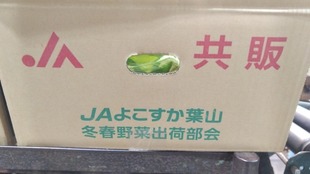
The agricultural products direct sales office “Sukanagosso (Nagai)” is a direct sales office that delivers seasonal fresh agricultural products by exhibiting vegetables that are proud of being grown by about 400 producers of JA Yokosuka Hayama. As an antenna shop that sends out “local food” that consumes locally produced ingredients, the store has a wide selection of morning-picked vegetables, flowers, and Hayama beef (produced in Kanagawa Prefecture / Miura Peninsula). A general term for Japanese black beef. Members of the “Miura Peninsula Dairy Association” select excellent Japanese beef cow pedigree and raise each one with great care. High quality, stable production and the best Tajima-type sire, which is said to be meat quality, is systematically selected. High-quality feed (marbled meat is self-mixed with heated grains such as rice and tofu lees), wasteful fat content is reduced, and the finest beef. It seems that it sells various products such as eggs and handmade side dishes. The soft serve ice cream from the local Sekiguchi ranch is also delicious and popular.
